Yes, I admit, I have not only watched, but “glommed” to the entire series – from the first episode to the last. And I am a self-confessed Viking fan!
Page Contents (click line to jump the text)

Intro
“The people of Kattegat stand on the beach and gaze after the fleet of Ragnar Lothbrok. The bow of Ragnar’s dragon boat cuts smoothly through the waves of the fjord – Floki, the shipbuilder, chuckles with satisfaction. He has built the boat quickly and flexibly. The fleet wants to sail to the Frankish Empire. From the coast of Normandy, Ragnar wants to row his boats up the Seine to conquer Paris.”
These scenes were actually shot in Ireland! The interior scenes were mostly shot at the modern Ashford Studios near the town of Wicklow. The town of Kattegat was built on the outside of the studios.
And in the nearby beautiful Wicklow Mountains National Park, many of the exterior shots were made. The Seine is actually the Boyne River north of Dublin.
A tour of the filming locations of the series Vikings
I have summarised the filming locations in Wicklow for you below in a wonderful day tour:
The stops on the Vikings filming locations round trip:
- Powerscourt Waterfall
- Lough Tay and Luggala
- Lough Dan
- Ashford Studios
- Glendalough
- Hollywood
- Blessington Lakes (Poulaphouca Reservoir)
- Sally Gap
- Powerscourt Waterfall
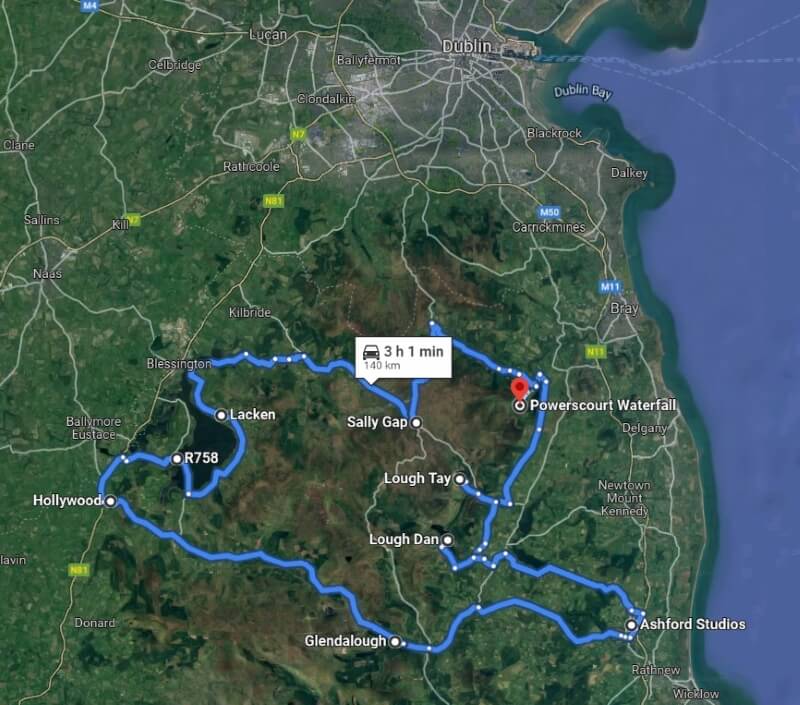
To 1. Powerscourt Waterfall
The Powerscourt Waterfall stands in the vast grounds of the Powerscourt Estate. Nearby is Powerscourt House and Gardens.
The house is more like a castle and the many gardens are very beautiful to visit. The waterfall can be visited free of charge and is picturesquely situated in a forest.
Princess Aslaug bathed here before she met Ragnar and soon became his second wife.
More information about Powerscourt and the Powerscourt Waterfall can be found online at: https://powerscourt.com/waterfall.
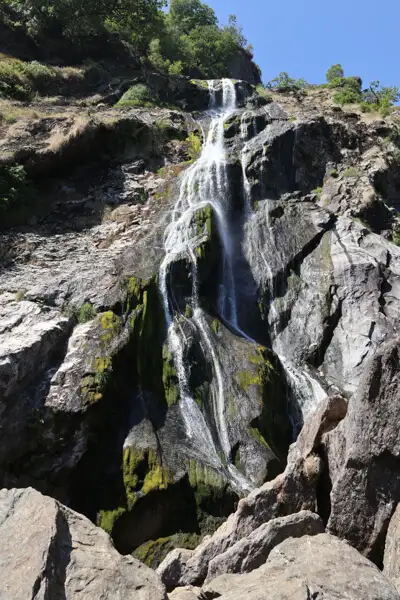
To 2. Lough Tay and Luggala
Luggala is a large private estate owned by the Guiness family – the name is no coincidence, the family also owns the brewery of the same name.
Many outdoor scenes for Vikings were filmed on the estate. The beautiful Lough Tay (Lough = lake) is surrounded by steep rock faces. On its beach there are individual small wooden houses – Kattegat was filmed here, especially the scenes at the harbour and on the beach.
On the high cliffs above Lough Tay, Ragnar and Björn stood and looked down thoughtfully on their town. The private property is not open to the public, but even from the road there are fantastic views of Lough Tay and the surrounding valley of Luggala.
The small road is very narrow and winds in tight curves along the mountain face – a highlight for motorcyclists.
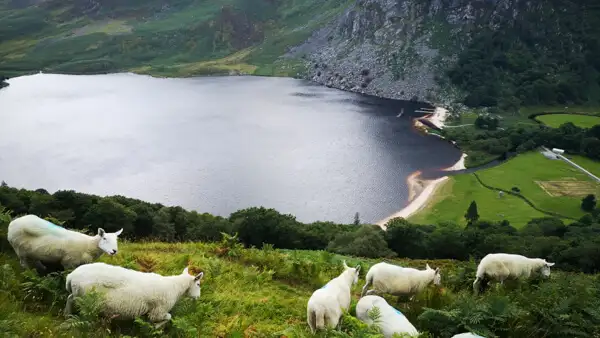
To 3. Lough Dan
A few kilometres further on is Lough Dan – somewhat hidden in the mountains.
Unfortunately, the small road does not lead directly to the water, but you can park in a public car park and walk a short distance to the lake.
Many scenes were also filmed in this beautiful nature on and around the lake. The Norwegian fjord in the film, was sometimes Lough Dan in reality.
To 4. Ashford Studios
Ashford Studios near the town of Wicklow was the home base for the series. From 2013 to 2020, the 6 seasons of the Vikings series were produced here.
The town of Kattegat was built on the outer grounds of the studios. Among other things, the siege and battle scenes of the city were filmed there. Link to the Ashford Studios: https://www.ashfordstudios.com.
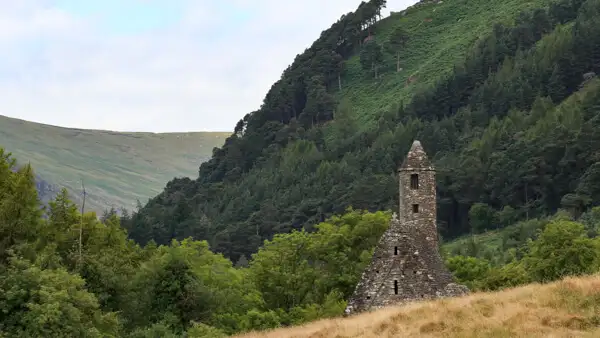
To 5. Glendalough
The mystical valley of Glendalough captured the imagination of people several thousand years ago. The name Glen-da-lough comes from the Gaelic and means Valley of the Two Lakes. The lakes are framed by high rock faces.
The atmosphere is magical and this place was already a holy place in Celtic times. In the Middle Ages, monks built an important monastic complex here, the Monastic City, the remains of which can be visited today.
The high mountains surrounding the valley are breathtakingly beautiful and many outdoor scenes for Vikings were shot in this gorgeous landscape.
It is highly recommended that you park your motorbike here, take a stroll through the medieval monastery complex and walk to the shore of the first lake. More information can be found at: https://glendalough.ie.
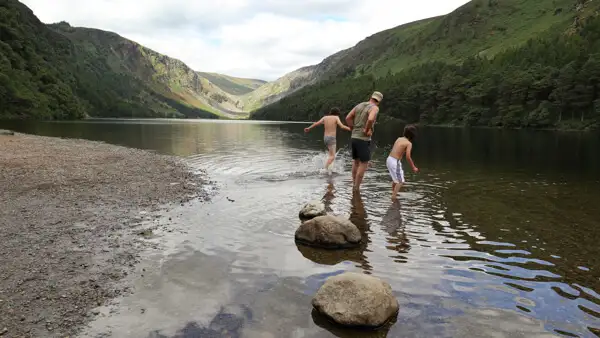
To 6. Hollywood
On the way to Hollywood (in Wicklow, not in California), first drive over Wicklow Gap. Gap means pass and at the top of the pass there are beautiful views over the valleys on either side. The mountains are dotted with former tin and lead mines.
You have seen some of the old mine buildings along the way. You head downhill again and at the foot of the Wicklow Mountains you reach the pretty little town of Hollywood.
Stop and look at the mountain face – following the Californian example, you will see the words “Hollywood” written in white letters on the mountainside. The whole landscape described, as well as the agricultural surroundings of Hollywood, were used for exterior shots of Vikings.
To 7. Blessington Lakes (Poulaphouca Reservoir)
The Blessington Lakes are a system of reservoirs, the Poulaphouca Reservoir. It is possible to drive completely around them, whereby the mountain side is particularly beautiful to drive by motorbike. Dragon boats have been sailed and rowed on these lakes several times – and of course filmed doing so.
To 8. Sally Gap and the Wicklow Way
From the lake back to the mountains: From the Blessington Lakes, the ride goes uphill and back into the beautiful Wicklow Mountains National Park. The junction at the top of the pass is called “Sally Gap”. Straight ahead you can again drive to Lough Tay, to the right you go again to Glendalough and to the left the Old Military Road, a former military road, leads along the ridge to the southern edge of Dublin. The ridge of the Wicklow Mountains is also followed by a famous high-altitude hiking trail, the “Wicklow Way”, on which the Vikings also hiked during their filming over the mountains of “Norway”.
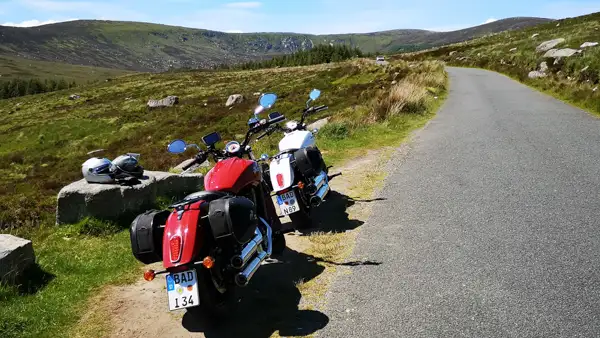
To 9. Powerscourt Waterfall
This is where the short round trip ends again. The Powerscourt Waterfall is the starting point and destination of the tour. By the way, the waterfall falls more than 100 metres into the depth and is thus the highest waterfall in Ireland.
Info about the tour
The destination of the round trip is again the Powerscourt Waterfall. The tour is about 140 km long. This doesn’t seem much at first, but on the small roads of the Wicklow Mountains the pace of travel is slow. If you enjoy the beautiful landscape and make a few breaks and photo stops, this is a full day’s tour.
The series’ role models: Were the Vikings in Ireland?
It is probably no coincidence that the Vikings film crew felt so at home in Ireland. Ireland does indeed have a long Viking history and is still very proud of it today.
The first Viking raids on Ireland are documented for the year 795 AD on Rathlin Island on the Northern Irish coast. This was shortly followed by further attacks on Inishboffin, Inishmurray and the Skellig Islands on the west coast and also on the region of present-day Dublin on the east coast.
Over the next 50 years, there were numerous raids and looting on all coasts of Ireland. Initially, the targets of the looting were mostly churches, monasteries and settlements near the coast. Later, the Vikings also advanced inland, often travelling up the rivers in their boats. The first Vikings in Ireland came from Norway and probably arrived in Northern Ireland via Northern Scotland. Later, Danish Vikings also came to Ireland.
The Vikings lived in their Norwegian homeland as farmers, fishermen, cattle herders and craftsmen. The rocky soils of their homeland yielded only a small harvest and the snowy winters were harsh. The raids into distant lands and later the development of trade routes promised a better livelihood for the Vikings.
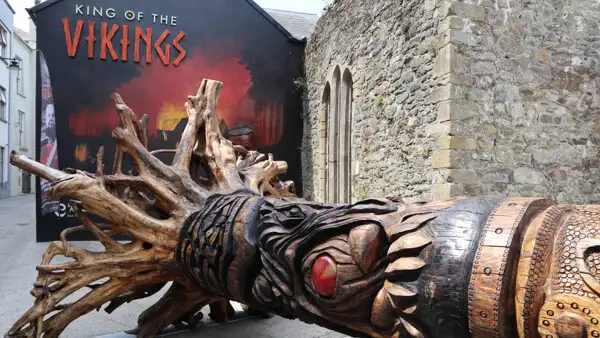
The Vikings followed the changing seasons, both in agriculture and in their raids: In spring they tilled their fields, when the spring storms subsided they sailed to England, Scotland and Ireland, where they raided monasteries and settlements over the summer, and before the autumn storms they sailed again to Norway, where they brought in their harvest and spent the winter.
Did the Vikings settle in Ireland?
Around 820 AD, Norwegian Vikings, and from 845 also Danish Vikings, began to build their first settlements on Ireland’s coasts and to spend the winter in Ireland. In 841 AD, the Vikings founded a settlement in the area of the present-day city of Dublin, which was expanded into a fortified city in 851. From 851 to 980 AD, the Vikings ruled the Kingdom of Dublin. In addition to present-day Dublin, the Vikings also founded the present-day Irish towns of Wexford, Wicklow, Waterford and Limerick.
As farmers, they soon recognised the value of the Irish soil. The climate was much milder than in their homeland and soon they began to build fortified settlements and winter in Ireland. At first, these settlements were little more than material stores and transshipment points for further raids. Increasingly, however, the Vikings wondered why they should return to their barren, rocky and snowy homeland for the winter when there was hardly any frost or snow on Ireland’s coasts, but green pastures all year round.
And so, over the years, the Vikings built increasingly more permanent houses, farms and villages and stayed in Ireland. The Vikings gradually stopped raiding and shifted to less risky and much more profitable trade.

With their excellent ships they sailed from Scandinavia along all the northern European coasts, up the great rivers Rhine and Seine and as far as the Mediterranean, North Africa and Arabia. They traded furs, silver and ironware for weavings, slaves, jewellery and spices, and even introduced the first monetary coins in Ireland.
Ireland’s important ports, Dublin, Waterford, Wexford and Limerick, became international trading posts. Where trade flourished, money circulated and where there was money, there was building: Over the years, small ports and settlements developed into large, fortified and important trading towns.
Is there a Viking heritage in Ireland today?
It has been scientifically proven through a DNA atlas that Scandinavian Vikings mixed with the Irish population over longer periods of time. However, DNA findings in the genomes of today’s Irish population point mainly to Vikings from the Norwegian north and west coasts.
Over the years, the Vikings began to practice more agriculture and trade in their settlements. The Scandinavian men took Irish wives in the new land and started families. The Irish and Scandinavian peoples increasingly mixed and “Gall-Gaels”, as the foreign and mixed settlements were called, came into being.
Today, there are numerous names and words in the Irish language that point to an ancient Norse origin.
For example, the present-day town of Wexford, founded by the Vikings, was called “Waesfjord” in Norwegian, which can be translated as the entrance to the mudflats or a sandy bay. “Waes” means sand or mudflats and a “fjord” is a sea bay. The name makes a lot of sense, because on the sandy coasts of the Irish southeast coast, the Vikings could land safely with their dragon boats even in rough seas. Sandy bays were therefore particularly suitable for harbours and Viking bases.
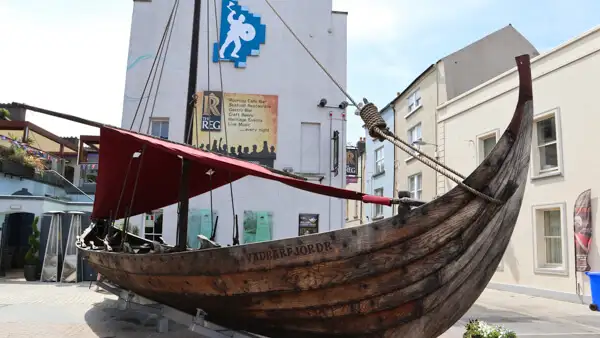
Where can you see Viking history in Ireland today?
The Viking Triangle in Waterford
The Irish are proud of their Viking roots. This is particularly evident in the Viking-founded city of Waterford.
There, at the harbour, is the Viking Triangle, a district with several museums, the Reginald Tower, a replica of a Viking dragon boat and a large museum exhibition dedicated solely to the Vikings. There is Viking graffiti in the streets and a Vikings hotel.
The Viking exhibition includes a virtual reality show and full-scale replicas and can be found online at: http://www.kingofthevikings.com/
Information on Reginalds Tower and other museums can be found on the web at: https://www.waterfordtreasures.com/.
Christ Church Cathedral and the Dublinia Viking Exhibition in Dublin
Christ Church Cathedral in the heart of Dublin is over 1000 years old and was built on the walls of a Viking church and is the oldest building in Dublin.
The imposing cathedral is well worth a visit. Information can be found online at: https://christchurchcathedral.ie/.
Right next door is Dublinia, a museum with a really nice and entertaining exhibition on Vikings and Ireland’s medieval history. Dublinia is definitely a recommendation for Viking and medieval fans! You can find it online at: https://www.dublinia.ie/.
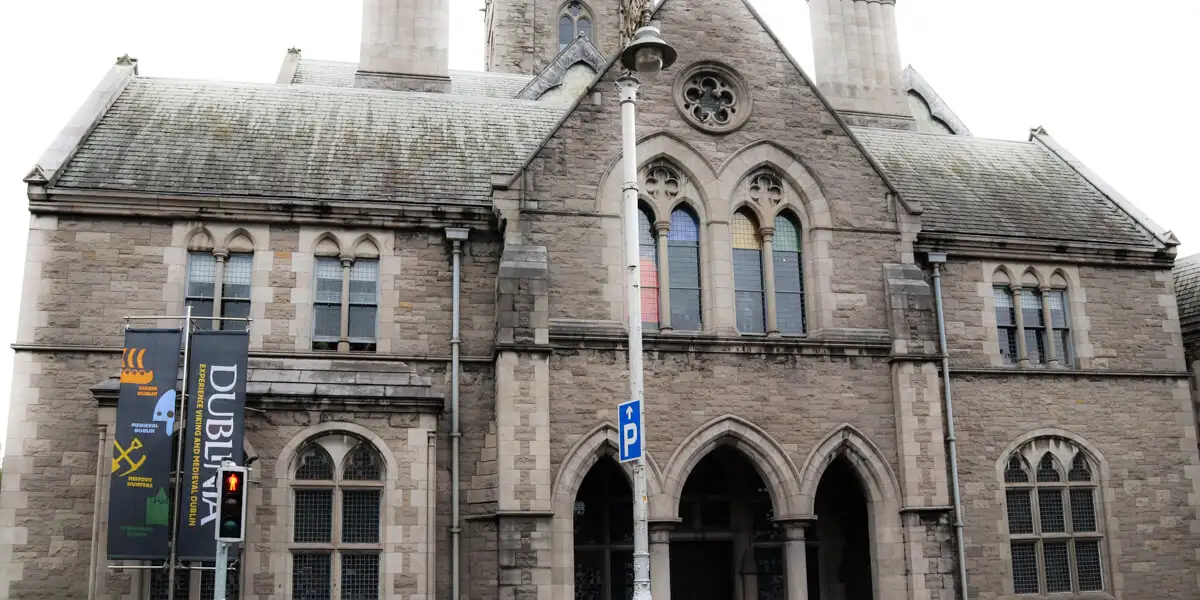
The Viking Ireland exhibition at the National Museum of Ireland in Dublin
This is a permanent exhibition on Vikings with archaeological excavations from the Middle Ages and highlights the approximately 300 years of Vikings in Ireland and their influence on Ireland’s development.
This link provides detailed information: https://www.museum.ie/en-IE/Collections-Research/Irish-Antiquities-Division-Collections/Collections-List-(1)/Viking/The-Viking-Age-in-Ireland.
The Irish National Heritage Park in Wexford
The extensive wooded grounds of the National Heritage Park on the River Slaney near Wexford are an open air museum. There, houses, buildings and objects of daily life in Ireland from prehistoric times to the late Middle Ages have been recreated.
The Vikings also have a permanent place in this exhibition. More information is available at: https://www.irishheritage.ie/.
Conclusion: Experience the Viking heritage of the Irish!
What kind of people were they who became the terror of Europe in the early Middle Ages with minimal equipment on their small boats, who traded from the Baltic to the Mediterranean and the coasts of Africa, who discovered Iceland, Greenland and even North America? They were certainly extraordinary people!
It’s not for nothing that series like Vikings become so successful!
The Vikings made history and had a huge impact on the lives of many people. Ireland’s population today carries a good share of Norwegian genes and the early Viking ports and settlements became thriving trading centres and important cities.
To this day, the Irish are proud of their Norse ancestors and you can visit and experience Viking history in many interesting places in Ireland.
If you feel the fascination of the Irish for the Vikings in you, then “experience” this tour to the Viking locations in the beautiful Wicklow Mountains!
More interesting articles for you
A JOURNEY TO 14 GAME OF THRONES FILMING LOCATIONS IN NORTHERN IRELAND
THE MOST BEAUTIFUL CASTLES AND PALACES ON THE IRISH ISLAND – 35 TIPS FOR YOUR ROUND TRIP
22 GREAT MOUNTAIN ROUTES AND PASSES FOR YOUR ROADTRIP AROUND IRELAND
WHISKEY TRAIL – TRACKING THE BEST IRISH WHISKEYS – 11 TOURING TIPS FOR YOUR TRIP TO IRELAND
Photo credits cover photo: Wood carvings with Viking motives in Waterford Viking Triangle. Photo by Ulrich Knüppel-Gertberg (www.irland-insider.de, www.ireland-insider.com)
Map of the filming locations: Google Maps